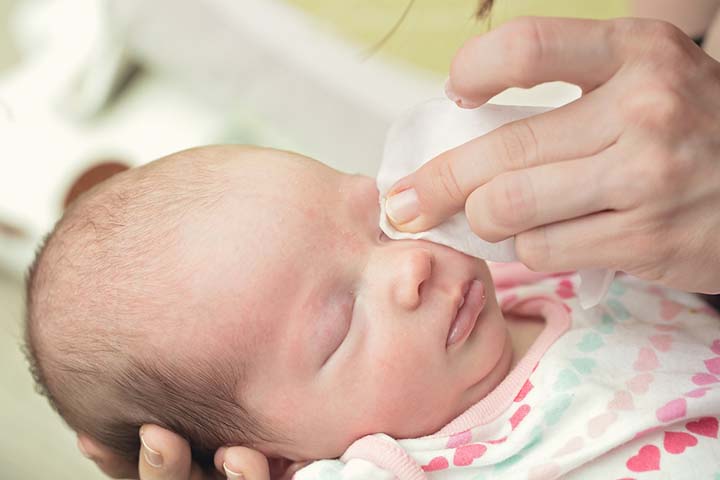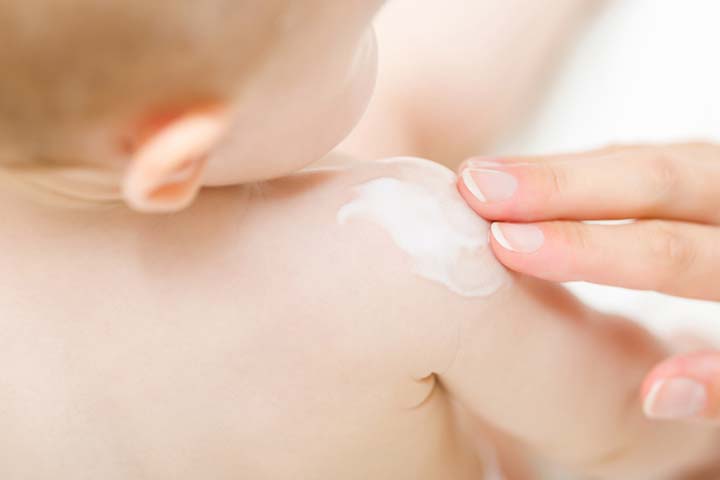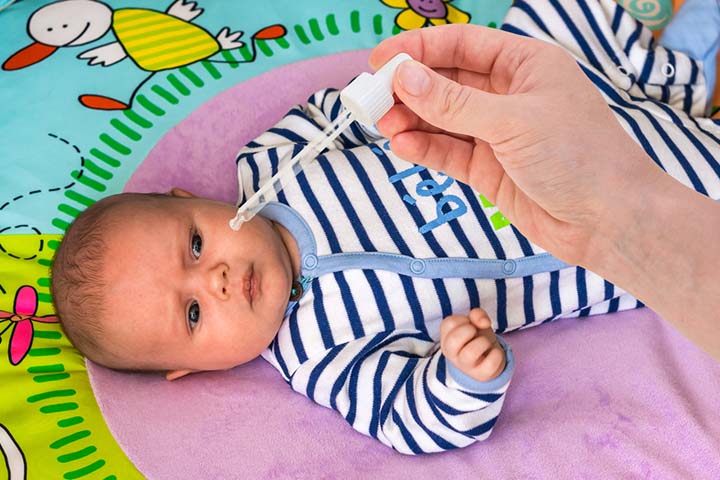Watery discharge from the eyes can cause eyelids to become sticky. Generally, sticky eyes in infants are associated with the presence of white or yellowish crust along the corners of the eyelids. The condition, though common, may cause irritation, blurry vision, and discomfort to the infant as their eyes seem to be glued shut. Keep reading this post to know what may cause sticky eyes in infants, its symptoms, home remedies, treatment options, and a few preventive measures.
Is It Normal For Babies To Have Sticky Eyes?
It is normal for babies to have sticky eyes, which often happens due to excessive tearing. One of the common causes of watery and sticky eyes is a blocked tear duct, which occurs in almost 20% of babies worldwide (1). Most causes of sticky eyes in newborns resolve during infancy. Therefore, do not panic if your baby’s eyes suddenly become watery and sticky.
What Are The Symptoms Of Sticky Eyes In Babies?
Sticky eyes are mostly presented by watery eyes, crusting at the corner of eyes or across the eyelid, and glued or matted eyelashes. It mostly happens in one eye but might occasionally occur in both eyes (1).
If the discharge from the eyes is not accompanied by other symptoms, such as redness, itching, or eye or eyelid swelling, then it is mostly not an infection.
When To See A Doctor?
See the doctor if the following symptoms accompany watery and sticky eyes:
- Redness of the eye
- Itchiness of the eye
- Fever
- Drainage of pus or red or green discharge from the eyes
- Swollen eyelids
- Eyes that are sticky for a long time
- Your baby seems sensitive to light
- Blinking excessively or constantly squeezing their eyes shut
- The side of their nose seems swollen
- the tear duct is still blocked by the time they reach one year of age
Rarely, the baby may have sticky eyes due to a tear duct malformation, which could cause a large bump at the inner corner of the eye (2). See a doctor promptly if you notice this symptom.
Causes Of Sticky Eyes In Babies
The following conditions may lead to sticky eyes in babies.
- Congenital nasolacrimal duct obstruction (CNLDO): It is the medical term for blocked tear duct, which drains excess tears from the eyes into the nose. A blocked or malformed tear duct could cause tears to remain in the eyes for long, thus leading to stickiness (1). This condition in babies is often congenital, and 95% of CNLDO cases resolve by themselves within the first year of the baby’s life.
- Dacryocystitis:It is an inflammation of the lacrimal sac (tear sac) (3) . This condition is usually less common and often occurs as a complication of blocked tear ducts with 2.9% cases reporting dacryocystitis as well (4).
- Stye or hordeolum: A stye is a bump caused by an infection of the oil glands or sweat glands present at the rim of an eyelid. Stye could have a yellow discharge (5), which might lead to the stickiness of the eyes.
- Conjunctivitis: The contagious eye infection can be bacterial, viral, or allergic. It leads to excess wateriness of the eyes (6), which can eventually lead to sticky eyes. The American Academy of Ophthalmology (AAO) reports that the prevalence of neonatal conjunctivitis in developed countries is estimated to be less than 0.5%. However, the numbers are estimated to be much more in the case of developing countries.
- Nasal anomalies:Congenital problemsiXStructural or functional abnormalities present since birth, occurring during pregnancy. of the nasal passages, such as nasal polypsiXSmall, benign growths in the nose or sinuses resulting from chronic inflammation or allergies. and nasal deformityiXAbnormal shape or structure of the nose, typically caused due to an injury, genetics, or medical conditions., might also cause excess tears (7). It might lead to stickiness in the eyes. The presence of a foreign body in the nasal passage might also make the eyes more watery and sticky.
- Upper respiratory tract infections: Common cough and cold or any other infections of the upper respiratory tract in babies might cause watery eyes (8), which may lead to sticky eyes.
- Allergies: Allergies can cause eyes to get itchy and watery (9), which might lead to sticky eyes. Pollen, food, pet fur, and even the fragrance of body lotions can lead to allergies.
Rarely, infantile glaucomaiXA condition where the fluid pressure inside the eyes may damage the optic nerve and impair vision. and corneal infections might cause watery and sticky eyes in babies(1).
Treatment For Sticky Eyes In Infants
The treatment aims at curing the condition behind watery and sticky eyes. The following treatment methods are usually used for babies.
- Nasolacrimal duct massage is a conservative and non-invasive approach to open up the blocked tear ducts . According to the American Academy of Ophthalmology, parents can do the massage by placing their index finger on the inner corner of the eye and the side of the nose. Press the spot gently and then slowly move fingers downwards along the edge of the nose. Perform ten strokes once in the morning and in the evening. Parents may discuss the steps and duration of the massage with the pediatrician (10).
- Nasolacrimal probing is suitable for children above the age of one year. Doctors insert a thin probe into the tear duct to remove the obstruction in the nasolacrimal duct. Doctors might choose this treatment only when tear duct massage has no effect (11).
- Antibiotic drops are commonly used to treat bacterial infections or neonatal conjunctivitis. They should be used only on a doctor’s prescription in the recommended dosage for the recommended duration (1).
- Medications for cough and cold: The doctor might prescribe oral drugs to treat an underlying condition such as an upper respiratory tract infection (12). The Centers for Disease Control and Prevention suggests that you may also use nasal saline drops and a suction bulb to get rid of mucus from the nose (8).
- Antihistamines might be prescribed by the doctor to treat allergy symptoms. However, the Seattle Children’s Hospital suggests using oral antihistamines if your child is two years or older. Antihistamine eye drops may be used in children above three years of age (13).
The pediatrician will help you identify the causes and plan the treatment accordingly.
Home Remedies For Sticky Eyes In Babies
Eyes are a vital organ, and thus it is best to leave the treatment of sticky eyes in babies to a doctor. You may take some steps at home to help manage sticky eyes, especially when the condition is not severe.
- Use a sterile cotton ball dipped in saline to wipe off the crust or extra tears on the corner of the eye. Use a fresh cotton ball for each wipe.
- If the crust has formed causing the eyelids to be glued shut to each other, use a warm, soft washcloth to wipe the crust away.
- You may regularly perform a tear duct massage at home after consulting a doctor.
Can You Prevent Sticky Eyes In Babies?
Sticky eyes cannot always be prevented, but you can minimize the risk by observing some precautions.
- Proper hygiene, like washing hands and keeping surroundings clean prevents exposure to allergens and pathogens. If a family member has an eye infection, then they should avoid contact with the baby. If primary caretakers develop an infection, then they should thoroughly wash their hands before touching the baby or their belongings.
- Maintain separate towels to wipe the baby’s body and face. It can help prevent the transfer of an infection or a surface pathogen from one part of the body to the eyes.
- Avoid exposure to allergens like pollen, dust, and strong scents.
Sticky eyes in infants are typical, caused due to water discharge from the eyes that become sticky, and this results in irritation and pain in babies. This condition has various causes, including CNLDO, nasal anomalies, respiratory infections, and allergies. However, the majority of these cases, depending on the cause, either resolve on their own through infancy or may be readily addressed. However, if your child’s eyes are swollen, itchy, red, or sticky for a longer duration, consult your baby’s pediatrician and ophthalmologist for proper diagnosis and treatment.
Key Pointers
- Sticky eyes are common in infants and are characterized by white or yellowish crusting, matted eyelashes, and watery eyes.
- Causes of sticky and watery eyes include blocked tear ducts, inflammation of the lacrimal sac, infection of oil or sweat glands, eye and respiratory tract infections, infantile glaucoma, corneal infections, nasal anomalies, tear duct malformations, and allergies.
- Medical treatment is necessary if redness, itchiness, pus, swelling, increased sensitivity, and fever occur. Treatment options include antibiotic eye drops, medications for underlying conditions, antihistamines, nasolacrimal duct massage, and probing.
- Home remedies and preventive measures can remedy sticky eyes in babies. These include using saline-based or warm wipes, giving tear duct massages, maintaining hygiene, avoiding allergens, and using separate towels.














